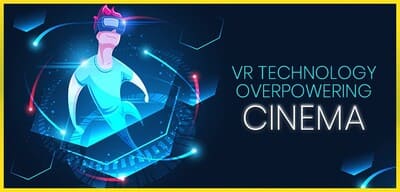VR Technology Overpowering Cinema
Craving a trip to the Maldives to look out for transparent water? Could you just go to your computer or turn on the TV? Do you wish to experience one of the world’s biggest roller coasters without leaving the sofa? Virtual Reality technology will make everything possible. Many of us think of science fiction films like ‘Avatar’ or ‘Tron: Legacy’ when discussing Virtual Reality (VR). However, this technology blends with our everyday lives, including functions like education, pharmacy, military, entertainment, video games, etc. Virtual Reality (VR) is transforming the entertainment industry every day. Although traditional gaming and entertainment fare needs little user interaction, VR technology provides users with a more customised entertainment experience where users interact through funky VR glasses with the magical world they’ve stumbled into. Innovations will no doubt continue to thrill those who want to slip away into their own private VR technology world. But what is Virtual Reality?


Virtual Reality is a computer-generated world that immerses the user in their environment with scenes and objects that appear to be accurate. An electronic device known as a virtual reality headset or helmet is used to perceive this world. In order to optimise performance, VR enables us to immerse ourselves in video games as if we were one of the characters, learn how to conduct open-heart surgery or undergo military training. While this might sound incredibly futuristic, it is not as recent as we would believe that its roots are. In fact, many people think that mid-1960s Sensorama (a computer with a built-in seat that played 3D movies) was one of the first virtual reality technology devices, which gave off odours and created vibrations to make the experience as lively as possible. Over the following years, subsequent technical and software advances brought with them a radical evolution in electronics as well as in interface design, leading to the development of VR glasses that provide a more lightweight and accessible version of the experience.
Without a doubt, the entertainment sector is one benefiting from the virtual reality technology craze. Many are guided to the theatre to constantly explore new and creative ways appearing in cinema. The entertainment industry will gradually move with it as technology progresses. Theatres will soon keep VR headphones instead of 3D glasses to watch a 3D movie, and will completely immerse the viewers in the action from scene one to the closing credits.
It’s fair to say that Bollywood began adopting virtual reality technology after Hollywood. The first Indian film to reach virtual reality was Eros International and Viki Rajani’s 2016 film Phobia, starring Radhika Apte and directed by Pavan Kirpalani. This was the first time a Bollywood movie welcomed its viewers into the house of its main character in a way that they would feel a part of it in real-time. The video was shot with a 360-degree camera, guiding viewers around the house from Radhika’s POV, experiencing similar unusual things she encounters in the film. The scene is spooky enough, but the terror is magnified when viewed through the virtual reality headset. Removing the head-mounted virtual reality headset is the only way out.
In 2016, they had a VR lounge at the Mumbai Film Festival and International Film Festival of India, showing a short three-minute video of Bahubali 2. Baahubali has so many VFX and digital assets that it made perfect sense to have the concept of virtual reality technology. Anand Gandhi, the national award-winning filmmaker of Ship of Theseus, also worked on VR technology. He made India’s first VR documentary, ‘When Land Is Lost, Do We Eat Coal?’, on the Korba mines in Jharkhand, bringing the visceral landscape alive and providing a first-hand experience of the destructive impact of mining on the KanwarAdivasis, who have lost their homes and access to drinking water and electricity.
The drive towards greater, stronger, more practical activity in the film and video game development markets allows investors to work on lavish new entertainment venues. Several theatres have added full bars, expanded snack options, and even table-side meal service. It will entertain viewers by incorporating a virtual reality headset component, adding viewing rooms filled with headsets, VR glasses, or even movie seats that rock and slide along with the on-screen action. Staffed VR arcade rooms will give busy parents a break so that they can catch a flick while their kids play. Virtual reality technology can change the entertainment industry if applied correctly.


CATEGORIES
- Data Science and Analytics
- Cloud Computing
- Data Analytics and Business Intelligence
- AI and Digital Systems
- Cyber Security and Digital Forensics
- Business Analytics & Intelligence
- Banking & Financial Services
- International Business
- Digital Marketing
- Research Paper
- Media & Entertainment
- Media Management
- Journalism and Media Production
- Media & Information Technology
- Visual Communication
- Game Development
- Sound Engineering
- Game Art & Design
- Photography
- Film Making
- Animation & VFX
Are you aspiring to become a proficient Film Making professional?
Look no further; we are committed to nurturing the potential of young minds. Are you ready to enhance your skills?


